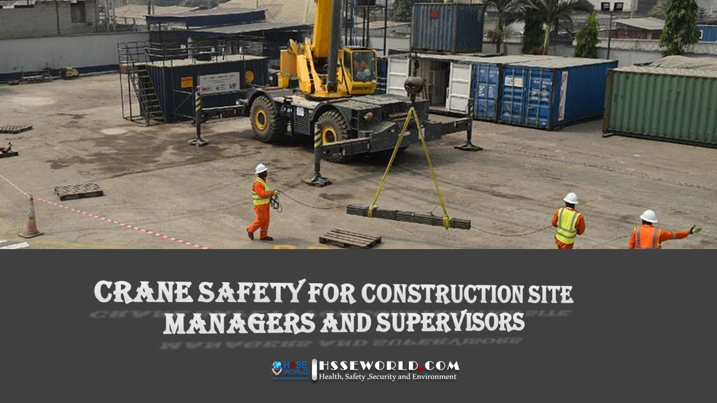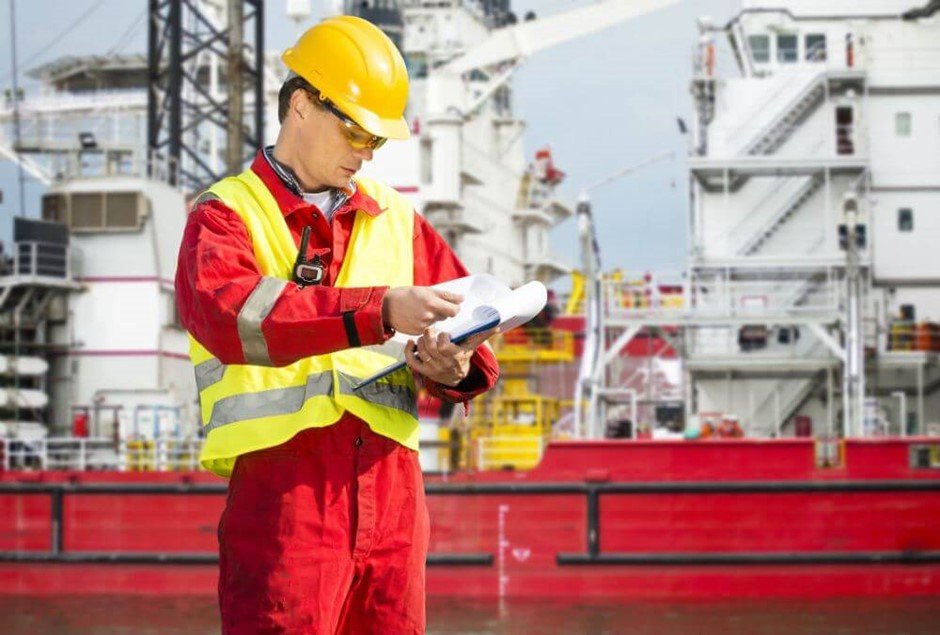As a site manager/supervisor you are responsible for coordinating health and safety on the construction site. This means you need to have an overview of all the activities happening on site. You also need to check that hazards are identified and controlled. This fact sheet provides information about the dangers associated with cranes and the steps to take to monitor crane safety.

Who is responsible for crane safety?
Safety is the responsibility of all parties involved in the operation of a crane. The Health and Safety in Employment Act 1992 places duties on employers, employees, principals, self-employed persons, and persons in control of certain types of plant and equipment (such as cranes) to take steps to keep the workplace safe. As a site manager/supervisor you play an important role in helping some of these duty holders fulfill their responsibilities.
What you should expect from crane controllers, operators, and dogmen?
Controllers should take all practicable steps to ensure that cranes are in a safe condition and are operated safely. They should ensure that they undergo regular inspections and proper maintenance (as advised by the crane manufacturer). Controllers must take all practicable steps to ensure that all operational cranes have a current certificate of inspection issued by a recognized inspection body. They have a duty to ensure that information about the safe operation of the crane and documents related to design verification and equipment inspection are readily accessible to crane users.
Note–Controler: Under the Health and Safety in Employment (Pressure Equipment, Cranes, and Passenger Ropeways) Regulations 1999, the term controller means a person who is the owner, lessee, sublessee, or bailee of a crane in a place of work
Controllers have a duty to ensure their employees are competent operators and that they have appropriate training and experience. Controllers need to be knowledgeable about crane operations so that they can recommend the best machine for the lift.
Crane operators need to have experience operating the particular crane they are using. They should follow the manufacturer’s instructions contained in the rating sheet, manuals, and operating procedures provided with the crane. Operators should follow their employer’s policies regarding regular and pre-start checks. The operator must never operate a crane until they are sure conditions are safe.
Note: Crane: The Approved Code of Practice for Cranes defines a crane operator as a person who has acquired, through a combination of training, qualification and experience, the knowledge and skills to operate a particular type of crane.
The dogman must have experience slinging loads and directing cranes. The dogman needs to take all practicable steps to ensure that the load is safely rigged for lifting and that the crane is directed safely for all movements of the load. They should work with the crane operator to understand the crane’s ability and plan the lift.
Note: Dogman: The Approved Code of Practice for Cranes defines a dogman as a person qualified to sling loads and direct the lifting and placing operations of a crane.
What could go wrong?
Accidents involving cranes cause significant harm and damage. Workers and bystanders can be severely injured or killed. Even if no- one is hurt the time lost and repairs following an incident can be costly. The table below highlights some of the dangers associated with crane operations.
| What could go wrong? | Possible causes |
|---|---|
| The crane could tip over. | – The crane is set up on soft, unstable or unsuitable ground. – The crane is not set up level. – The crane is positioned above underground services. – The outriggers of a mobile crane are not fully extended or used as directed in the manufacturer’s instructions. – Insufficient counter weights are used. – Wind. – The weight of the load is calculated incorrectly. |
| The structure of the crane could fail. | – The rigging components are overloaded. – The load swings or drops suddenly. – The load is hoisted beyond the capacity of the crane. – The crane has not been maintained properly. – The crane has not been assembled properly. – The weight of the load is calculated incorrectly. |
| During the lift the boom of the crane could hit people, structures or other plant in its path. | – There is insufficient clearance between the crane and other structures or plant. – The path of the load is not carefully planned. – Safe zones are not maintained and unauthorised people enter the lift area. |
| The dogman, ground workers and/or crane operator could be electrocuted. | – The crane comes in contact with overhead power lines. – There is an arcing of electrical current when the crane comes close to power lines. |
| Objects could fall off the load being lifted and hit people, structures or other plant. | – Material is not properly secured. – The load is rigged incorrectly. – Safe zones are not maintained and unauthorised people enter the lift area. |
| The load could be dropped. | – The lifting equipment has not been maintained. – The lifting equipment is not rated. – A component of the crane fails. |
What can site managers/supervisors do to ensure safe crane operations?
Site managers/supervisors need to be involved throughout the planning and operation stages of the project. The following sections describe the steps you can take to monitor safety practices at each stage.
Before the crane arrives:
Consult with the controller to find out what they require to ensure safe access to the site, and for crane assembly, lift and exit. Some things to consider are:
- Is the ground where the crane will be set up level and compacted?
- How will access be managed? Consider access to the staging area, other traffic, and separation of plant and pedestrians.
- Is there enough space to deploy the outriggers of a mobile crane and to extend the boom?
- Is the work area a safe distance away from excavations, shoring, trenches, buried utilities, and foundations?
- Will the crane and/or load encroach on power lines?
- Who will contact relevant utility services if required?
- How will an emergency be managed?
- Who will be responsible for contacting the emergency services, ensuring rescue equipment is available, coordinating the rescue, evacuating the site, making the accident scene safe and reporting the accident?
When the crane arrives:
- Consult with the crane operator to confirm access and emergency management details.
- Ensure that operator, dogman, and other ground workers have completed a site-specific induction.
- Issue any relevant permits to work.
- Audit the documents listed in the next table.
Regular checks are an important part of safety management and a useful way to ensure that crane controllers and operators are meeting their duties. The table below provides a brief description of some of the documents that should be available to you and the crane operator.
| What to check | |
|---|---|
| Lift plan | Lift plans should be documented for a big or complex lift. The lift plan will likely detail: – The specifics of the load such as weight and size – The path of travel and strike hazards – who will be involved in the lift and their responsibilities – methods of communication during the lift. |
| Operator qualifications | Check that the crane operator and dogman are competent. Qualifications they may have are: – Unit Standards that assess crane operation skills – A governmental Certificate in Cranes. Other relevant experience includes: – crane manufacturer’s training – in-house training – experience using the type/model of crane being used – knowledge of operating procedures, load-limits and warning devices. |
| Crane erection crew qualifications | Check the crane erection crew are competent. Qualifications they may have are: – Unit Standards that assess crane erection skills – A Governmental Certificate in Cranes. Other relevant experience includes: – crane manufacturer’s – training. |
| Dogman qualifications | Check the dogman is competent. Qualifications they may have are: – Unit Standards that assess slinging and communications skills – Governmental Certificate in Cranes (Dogman Operations). Other relevant experience includes: – rigging training – in-house training. |
| Pre-start/ regular checks | Pre-start checks will vary depending on the type and manufacturer of the crane. Operators are likely to have a checklist that they complete daily or pre-start. Checklists may include (but are not limited to): – visual checks such as checks for wear or damage to the structure and its associated parts – operational checks such as checking that the controls are functioning properly and mechanical parts are moving smoothly. |
| Certificate of inspection | The controller is responsible for ensuring that the crane has a valid certificate of inspection. The certificate may be displayed on the crane. If it is not the controller must make it available on request. |
| Lifting equipment | – Lifting equipment should have a tag indicating the safe working load and the manufacturer’s instructions for use. – A lifting equipment register showing inspection dates should be available on request. |
| Other documents | Other documents that should be accessible to the operator include: – manuals – operational procedures – rating sheets. |
Before the lift:
Discuss the lift plan with the operator, dogman, and other persons involved in the lift. Make sure you understand the hazards identified (including those covered in the ‘What could go wrong’ section of this factsheet) and you are satisfied that they have been appropriately controlled.
Ensure that the hazards and controls are communicated to all workers and anyone else in the vicinity that may be affected. Communication methods include:
- permit to work systems
- hazard boards
- hazard signs
- barriers
- spotters.
During the lift:
Ensure:
- safety zones are maintained
- workers are following safety instructions
- the lift plan is being followed.
After the lift:
- provide feedback to the operator and dogman
- cancel any permits to work
- raise any health and safety or operating concerns with the controller
- discuss any areas for improvement with site workers at the next site meeting.




